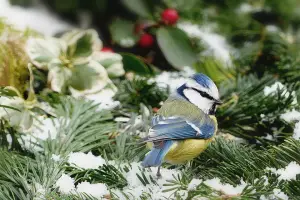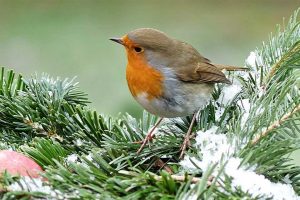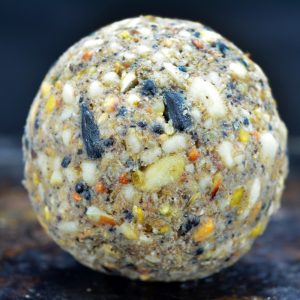Garden birds need our help to supplement their diet, never more so than during winter, when the cold, harsh temperatures threaten their existence.
That isn’t to say that there isn’t natural food available; it is just harder to come by.
Keeping the birds safe and warm is partly our responsibility, so it is useful to know what food birds eat in winter.

Just as in the spring and summer when food sources are plentiful, birds eat any berries buds, seeds and insects that they find. It often takes more cunning and guile to forage out natural food, especially from beneath the snow.
To help in their quest for survival, there are many foods that we can offer to supplement the birds’ diet. What you put out depends on the species that visit your garden, though foods high in carbohydrates, such as fat-filled suet balls and pellets, are a good way of getting stored energy and heat into their bodies.
Table of Contents
Should birds eat more during winter?
Birds need food to give them energy. They build fat stores within their bodies to help keep them warm. Small birds have a large surface area considering their small volume; much of their natural body heat escapes this way.
To stand a chance of making it through the hardest time of year, garden birds need to eat a third of their body weight, daily.
What birds find to eat in winter
Different species of bird have varying preferences for natural food. When harsh weather or seasonal conditions render their food scarce, most birds get resourceful and search for something new.
Don’t forget; it isn’t only birds native to the UK that winter here. Migrants from Scandinavia, Russia, and Continental Europe choose to spend the colder months here as the climate is more favourable than theirs.

Robin – Robins love insects, especially worms and beetles. If the ground freezes, it creates a barrier. Thus, the red-breasted chap looks elsewhere for small tree fruits, such as cherries and hawthorns. They look for any trees, shrubs, and bushes with winter berries and fruit.
Chaffinch – They are seedeaters and scour woodland to find seed heads that have matured late in the year.
Goldfinch – Just as their cousin, the chaffinch, they forage looking for filled seed heads. Their strong beak makes light work of penetrating the husk.
Brambling – Not only do they look like the chaffinch, but the brambling also feeds like one. They are big seed eaters but head to woodland to hunt our beech mast during the winter. Their Scandinavian counterparts join them there, where they gather in large flocks.
Blue tit – The instantly-recognisable fella is a frequent garden visitor in winter. Their usual diet of insects, aphid, caterpillars, and millipedes are scarce to come by. They supplement their diet with fruit where possible, and forage for grains, seed, or nuts from the beech or hawthorn.
Blackbird – Some blackbirds head south for winter, but those that stay struggle to find their favourite worms during frost and snow. They rely on wild berries or seeds, although they spend hours foraging through leaf piles and vegetation for worms.
What food should we feed birds in winter?
When you have some idea of the most frequent visitors to your garden, you can tailor the food you leave out to their requirements.
If you have a wide variety of feeders, it makes sense to offer a wide variety of food.
If you’re only going to put a single feeder out, I would recommend a suet based product. Fat balls, pellets, blocks, or filled-coconut shells all supply much-needed fats, therefore, energy and warmth in winter.
- Sunflower seeds
The sunflower seed is one of the most nutritious and efficient foods that you can feed a wide variety of garden birds.
I prefer to give my birds sunflower hearts; the pre-shelled edible centre of the seed. They are mess-free and minimise the risk of germinating beneath the bird table.
If you prefer whole pods, opt for Black Oil sunflower seeds. Their thinner shells and very high oil content are perfect for the winter, and the birds can shell and eat large quantities in little time.
Robins, blackbirds, thrush, wren, tits, and sparrows enjoy sunflower seeds. They are versatile; scatter them on the ground or pop them into tube or platform feeders.
- Mealworms
Live mealworms are packed with protein, fibre, and fats. They are a great supplement to a bird’s diet but don’t supply full nourishment, so only offer them as a treat.
Live worms die at temperatures below 5°C, so they don’t survive on the coldest winter days.
Dried mealworms are a good option, soak them in warm water first, this not only gives them a more eye-catching appearance, but it also keeps the birds hydrated.
Robins and blackbirds enjoy meal worms sprinkled on the ground, finches and siskins will venture onto bird tables to get to them.
- Nyjer seeds
These tiny black seeds are rich in oil and have a high nutritional value for birds. The only way to entice the birds to them is with a designated nyjer feeder with mesh holes too small for them to fall through.
Many small birds benefit from nyjer in their diet during winter, including tits, finches, and sparrows. Nuthatches will have a nibble; and if you’re lucky enough to have a visiting woodpecker, they will devour any spilt seeds that they can get.
- Peanuts
I always crush peanuts before feeding them to my birds. I am concerned that an adult may inadvertently choke a hatchling on a large piece.
During cold winters robins and wren will feast on peanuts as they’re loaded proteins and healthy fats.

- Fruit
As the seasons’ cycle, trees become bare with no fruits to offer the birds. Instead, offer them leftover fruit, cut into manageable size chunks. Scatter some apple or pear halves beneath the bird table for the ground feeders.
Fruity kebabs are perfect for hanging from hooks and feeding stations.
I recently saw Matt Baker feeding fruit onto lengths of string and hanging it around his many trees. The beautiful colours and aromas attract the birds and give the sparse trees an autumn and winter makeover.
Most fruits are appropriate; apples, oranges, pears, grapes, and plums pique the interest of all sorts of garden birds. They contain simple sugar and are a good source of energy, the water content keeps them hydrated when other water sources have frozen over.
Finches love melon, strawberry, and peach, starlings will try any fruit and most vegetables.
- Suet
Shop bought fat balls, suet balls and pellets are better than nothing, but home-made suet balls are much more appetising and nutritious for wintering birds.
Softened lard or beef suet from the butcher is the base, to which you add as many bird-safe scraps that you like. Once they’re well mixed, you chill them to set before hanging them in the garden.
Just some of the ingredients you could use include;
- Porridge oats
- wholemeal bread crumbs
- crushed peanuts
- mixed birdseed
- sunflower hearts
- dried mealworms
- grated mild cheese
- cake crumbs
- sultanas
- raisins
It is a wonderful, worthwhile activity with children and grandchildren. The pure fat content is high in calories which equates to high-energy levels and fat storage to keep the birds’ little bodies warm overnight.
Many birds enjoy suet, blue tits have a particular fondness for it, as do woodpeckers.
It doesn’t only have to be toasts crumbs and leftover bread that birds enjoy, or that will help them survive winter. There are multiple scraps in our everyday use that birds will devour.
For instance, they enjoy cooked rice and pasta, cereal, or a little grated cheese, as long as it is mild.
Leftover vegetables, boiled eggs, and baked potatoes are healthy and nutritious snacks for hungry wild birds.
Blackbirds like a slice of banana or a sprinkling of raw, never cooked, porridge oats.
Magpies and crows might devour a whole boiled egg while a chopped up one provides a filling meal for sparrows and robins.
Cooked rice is an excellent source of carbohydrates for all birds; please remember not to add salt during the cooking process.
Don’t scrape your cake crumbs into the bin, instead, pop them onto the bird table; it isn’t only us who benefits from a sweet treat and a sugar rush.
Final thoughts
We need to pull together and do all we can to ensure that as many of or feathered friends as possible make it through the winter months.
Always have a supply of clean drinking water and remember to keep their feeding areas clean.
Over-feeding can be almost as dangerous as under-feeding; rotting food can cause stomach upsets that might result in death.
Finally, by planning and planting early, you might give your birds food to eat in winter, with very little effort. Rowan and ivy produce late crops of berries that are nutritious to wild birds. The evergreen bush harbours many insects trying to hibernate, yet unwittingly become food for foraging birds.

What a helpful article. Thank you! I have started feeding the birds for the first time this winter and already have dozens of daily feathered visitors.